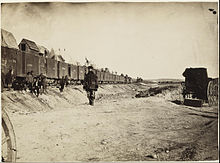At the SHS meeting in SLC that I plan to attend, there is to be a talk about the Transcontinental Railroad, which made the east-west connection in Utah. As homework, I was looking at the Stephen Ambrose book Nothing Like it in the World.?ÿ A friend pointed out to me that historians have noted an excessive number of corrections to the book.?ÿ The corrections don't seem to change the big picture, but so many details are wrong that it is unsettling.
If you are interested in this topic, you may want to read the book but should peruse the corrections. General comments:
https://en.wikipedia.org/wiki/Nothing_Like_It_in_the_World
Detailed list:
http://cprr.org/Museum/Books/Comments-Ambrose.html
?ÿ
?ÿ
I believe Ambrose did his best; to accurately depict what actually happened. How do we know that the "historians" are correct...
A distant relative lead the rust eaters. 5'4" and carried a bull whip...


How do we know that the "historians" are correct...
A lot of the corrections listed on the site I linked quote documents from the era.?ÿ A few may be deductions with less documentation.
Tell me have you the story of the Jupiter - and the 119?
The corrections don't seem to change the big picture,
I agree. I always viewed the books as "historical fiction" because of his writing style. I've only read three of his novels, Undaunted Courage, Nothing Like it in the World, and Crazy Horse and Custer all of which i enjoyed thoroughly. I'm also a big John Grisham fan.?ÿ ?????ÿ
Good to know re: Ambrose's book.
A book I recently skimmed through was The first transcontinental railroad, by John Debo Galloway
Galloway was a civil engineer, and the book was first published in 1950. I found it beneficial because he discussed the railroad grades in a fair amount of detail. It's free online, though our community college library had a copy, so I read the hard copy. I didn't do any fact checking.
I find the topic of the building of the transcontinental railroad very interesting. In fact, I just finished my last GIS class, which is a project class (topic of our choice), and I analyzed the transcontinental railroad. I compared the grade of the route of CP to UP. I was unsuccessful in reaching my initial goal (the slope values were unrealistic, 2-3% grade is what I should have come up with), but I had a lot of fun "cleaning up" the railroad line using geo-referenced historical USGS maps and old train timetables. I started off with an existing shapefile, added all the stations and found the geodesic distance between them and compared to the published distances in the timetables. (didn't account for terrain changes in my distance calculations).?ÿ?ÿI ended within 20 miles of the total distance.?ÿ
I now want to go see all these ghosts towns in Wyoming and Nebraska.
Lots of trivia ??.for anyone interested. 🙂
From Peter A. Dey, civil engineer for UP who quit because he had integrity. .."when you reflect upon the fact that I have resigned the best position in my profession this country has ever offered to any man."?ÿ I can't get the link to the document working, but it's House Documents, 1873.?ÿ Free google ebook.
If you haven't seen the TV series Hell on Wheels, I recommend it. Definitely fiction, but good entertainment.
Christina Epperson (Utah State History Project) ?ÿhas done a great job with these web maps. Railroad
distance - (that I also verified with my GIS map) - "greatest divergence from the great circle route was 110 miles" between Omaha and Sacramento. I actually measured less than 110 miles.?ÿ
Library of Congress has a lot of railroad maps. I had to use this one in my project, as the USGS maps that USGS has geo-referenced were all too "new".
On the highest point, Sherman's summit:
SHERMAN'S SUMMIT, APRIL 16, 1868 via CHEYENNE, APRIL 17
To Leland Stanford, President Central Pacific Railroad
We send you greetings from the highest summit our line crosses between the Atlantic and Pacific Oceans, 8200 feet above tide-water. Have commenced laying iron on the down grade westward.
T.C. DURANT Vice-President, Union Pacific Railroad
______________________
OFFICE CENTRAL PACIFIC RAILROAD COMPANY SACRAMENTO, APRIL 17, 1868
To T.C. Durant
We receive your greetings with pleasure. Though you may approach the union of the two roads faster than ourselves you cannot exceed us in earnestness of desire for that great event. We cheerfully yield you the palm of superior elevation; 7042 feet has been quite sufficient to satisfy our highest ambition. May your descent be easy and rapid.
LELAND STANFORD President, Central Pacific Railroad Company
Lastly, USPS has issued some lovely stamps commemorating the 150th anniversary. I just received mine in the mail and they're beautiful.
If the historical meeting is webcast online, let me know. I'd be interested in listening in.
The 1873 link didn't work.?ÿ The RAILROAD link is wonderful.
Here is another good book (so they say) that I picked up a few years ago. Still sitting on my shelf...I will get to it though.
?ÿ
I believe Ambrose did his best; to accurately depict what actually happened. How do we know that the "historians" are correct...
?ÿ
The same way we know a good resurvey is correct, they refer to reliable sources.?ÿ
My uncle, who just recently passed away, gave me an extra copy of a volume from "Reports of Explorations and Surveys to Ascertain the Most Practical and Economical Route for a Railroad...". These 12 or so volumes contain the data from the guys doing the actual work back then. If you want to dig deep these books have been scanned and are available online https://www.biodiversitylibrary.org/bibliography/11139#/summary
Link look crazy long, but let's see how it works. I couldn't get it to work the regular way. This is for the House proceedings.
?ÿ





